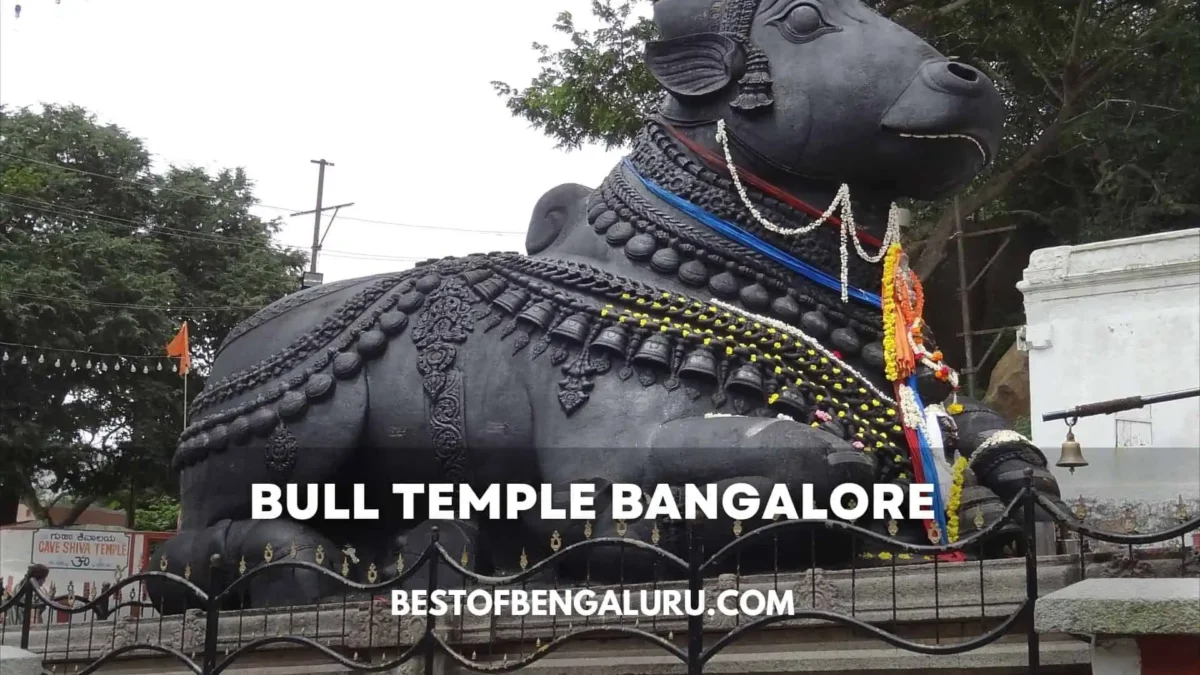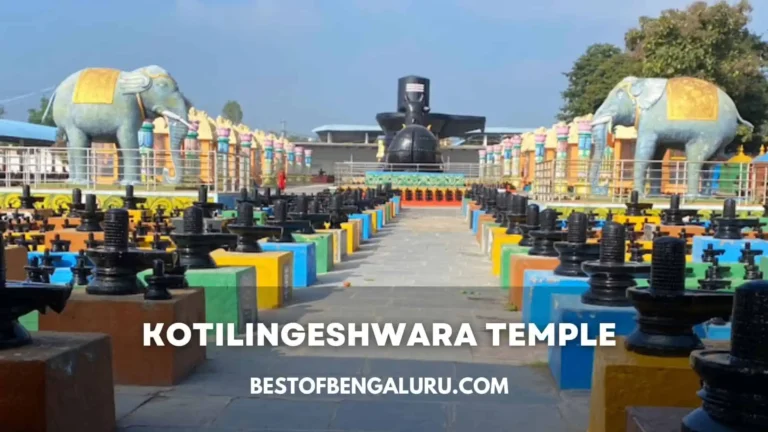Bull Temple Bangalore Basavanagudi Timings, Entry Fees, History, How to Reach
If you are looking for a unique and ancient temple to visit in Bangalore, you might want to check out the Bull Temple Basavanagudi. This temple is dedicated to Nandi, the sacred bull that serves as Lord Shiva’s mount. The temple houses a huge statue of Nandi, carved from a single rock, that is said to be one of the largest in the world. The temple also has a rich history and legend behind it, as well as a colorful annual festival that attracts thousands of devotees and tourists.

In this article, we will tell you everything you need to know about the Bull Temple Bangalore, including its timings, entry fees, history, and how to reach it. Read on to find out more about this fascinating attraction in the city of gardens.
Consider reading: Top 10 Famous Temples in Bangalore: Must Visit, Best, Historical and Old Temples
Bull Temple Bangalore Basavanagudi Timings and Entry Fees
| Temple Name | The Bull Temple Basavanagudi |
| Location | Bangalore, India |
| Timings | 6:00 AM to 8:00 PM |
| Break | 12:00 PM to 5:30 PM |
| Entry Fee | Free of charge |
Bull Temple Bangalore Basavanagudi Location and How to Reach by Bus and Metro
Accessibility and Location: The Bull Temple, a pivotal landmark nestled in Basavanagudi, owes its name to the iconic temple dedicated to Nandi, the celestial bull. This locality is well-connected, ensuring visitors can easily access the temple through various transportation means including buses, metro, taxis, auto-rickshaws, or personal vehicles.
Transportation Options:
- By Bus: Bangalore’s robust bus network offers a convenient route to Basavanagudi. Opt for buses heading towards N.R.Colony, Srinagar, or Thyagaraja Nagar. Key bus numbers include 210-NA, 34, 43E, 45-D, and 46A1, all facilitating a smooth journey to the temple vicinity.
- By Metro: For those favoring rapid transit, the National College Station on the Green Line stands as the nearest metro halt. Alight here and enjoy a brief 15-minute walk or a quick auto-rickshaw ride to reach the Bull Temple.
- By Taxi or Auto-rickshaw: Taxis and auto-rickshaws provide a direct and hassle-free means to navigate to the Bull Temple from any city corner. The fare varies based on distance and traffic, offering a flexible yet affordable travel option.
- By Car or Bike: Personal vehicle owners can rely on Google Maps or similar navigation tools for precise directions. While the temple premises accommodate parking, it’s wise to arrive early or sidestep peak times to avoid congestion, especially during festivals or holidays.
Consider reading: Isha Foundation Bangalore, Adiyogi at Chikkaballapur: Address, Opening Time, Entry Fee, and Tickets
History of the Bull Temple
The Bull Temple Bangalore, also known as the Nandi Temple or Dodda Basavana Gudi, is famous in Bangalore. Here’s a brief history of this remarkable religious site:
- Construction: The Bull Temple was built in the 16th century by Kempe Gowda, the founder of Bangalore. It was constructed to honor Nandi, the sacred bull and vahana (vehicle) of Lord Shiva.
- Legend of the Bull: According to Hindu mythology, a bull named Nandi played a crucial role in saving the world from destruction. As a result, Nandi is worshipped as a symbol of strength, fertility, and virtue.
- Historical Significance: The temple holds immense historical and cultural significance. It represents the rich heritage of Bangalore and is considered one of the oldest temples in the city.
- Dravidian Architecture: The Bull Temple showcases exquisite Dravidian architectural style, characterized by its distinct tall towers and intricate carvings. The temple’s elegance and grandeur are a testament to the craftsmanship of the artisans of that period.
- Preservation of Tradition: The Bull Temple has been a place of religious worship for centuries, attracting devotees from far and wide. It has remained a symbol of faith and devotion, preserving the age-old rituals and traditions of Hinduism.
- Renovation and Expansion: Over the years, the temple has undergone several renovations and expansions to accommodate the growing number of devotees. Despite these changes, it has managed to retain its original essence and charm.
- Cultural Festivals: The Bull Temple is a hub of cultural festivities. One of the most popular events held here is the Karaga festival, celebrated with great pomp and show. This festival showcases the vibrant culture and traditions of Karnataka.
- Tourist Attraction: The Bull Temple has become a major tourist attraction in Bangalore due to its historical importance, architectural marvel, and spiritual ambiance. Visitors from all over the world come to admire the colossal statue of Nandi and experience the divine aura of the temple.
The Bull Temple holds a special place in the hearts of the people of Bangalore. Its rich history, architectural brilliance, and religious significance make it a must-visit destination in the city.
Consider reading: Jagannath Temple Bangalore Timings, Prasad, Food and Parking
The architecture of Bull Temple Bangalore
The Bull Temple Bangalore is renowned for its stunning architectural design, showcasing the rich Dravidian style of craftsmanship. Here are some key architectural features of this famous temple:
- Dedicated to Nandi: The temple is dedicated to Nandi, the sacred bull and the vahana (vehicle) of Lord Shiva. It features a colossal statue of Nandi carved out of a single granite monolith, standing as a prominent symbol of devotion.
- Dravidian Style: The temple’s architecture follows the traditional Dravidian style, characterized by its elaborate detailing, intricate carvings, and pyramid-shaped towers (gopurams). This architectural style is prominently seen in many ancient temples of South India.
- Monolithic Nandi: The main attraction of the temple is the monolithic statue of Nandi, which stands at an impressive height of approximately 4.5 meters and stretches over 6 meters in length. This massive sculpture is believed to be one of the largest monolithic Nandi statues in the world.
- Ancient Construction: Built during the 16th century by Kempe Gowda, the founder of Bangalore, the Bull Temple is considered one of the oldest temples in the city. Despite its age, the temple has been meticulously maintained, preserving its historical significance and architectural grandeur.
The Bull Temple’s architectural brilliance and historical significance make it a must-visit attraction in Bangalore. The intricate carvings, the towering gopurams, and the awe-inspiring statue of Nandi are testaments to the craftsmanship of ancient builders.
consider reading: Art of Living Bangalore, Sri Sri Ravi Shankar Ashram, Timings, Distance, and Entry Fee
Nearby Temples
When you visit the Bull Temple Bangalore, there are several other temples nearby that are worth exploring. Here are some of the notable ones:
- Dodda Ganesha Temple: Located in Basavanagudi, this temple is known for its large Ganesha statue. It is believed to be one of the oldest Ganesha temples in Bangalore and attracts devotees with its unique architecture and religious significance.
- Shri Nimishamba Devi Temple: Situated in Raja Rajeshwari Nagar, this temple is dedicated to Goddess Nimishamba. Devotees visit the temple to seek her blessings for good health, prosperity, and happiness. The serene surroundings and the spiritual ambiance make it a peaceful place to meditate and offer prayers.
- Ragigudda Anjaneya Temple: Located in Jayanagar, this temple is dedicated to Lord Hanuman. It is known for its massive Hanuman statue, which is placed inside a large rock cave. The temple is a popular pilgrimage site and a perfect place for devotees to strengthen their faith.
- Banashankari Amma Temple: Situated near the Bull Temple, this ancient temple is dedicated to Goddess Banashankari. It is believed that the goddess fulfills the wishes of her devotees. The unique feature of this temple is the 9th-century idol of the goddess, which is carved out of black stone.
Visiting these nearby temples will enhance your spiritual experience in Bangalore and allow you to explore the rich religious heritage of the city.
Consider reading: ISKCON Temple in Bangalore: Timings, Tickets, Entry Fee, Distance and Photos
Final Thoughts on Bull Temple Bangalore Basavanagudi
The Bull Temple Bangalore is a remarkable attraction that showcases the ancient and cultural heritage of the city. It is home to a gigantic statue of Nandi, the sacred bull of Lord Shiva, that is carved from a single rock and is one of the largest in the world.
The temple also has a fascinating legend and a vibrant festival associated with it, which make it a popular destination for devotees and tourists alike. The temple is open to visitors every day, from 6:00 AM to 8:00 PM, with a break from 12:00 PM to 5:30 PM, and there is no entry fee to enter the temple premises.
The temple is easily accessible by various modes of transport, such as bus, metro, taxi, or auto-rickshaw, from different parts of the city. The Bull Temple is a must-visit attraction for anyone who wants to experience the history, spirituality, and culture of Bangalore.
So, don’t miss the chance to visit this temple when you are in Bangalore, and make sure to check its timings and entry fees before you go.
Consider reading: Shivoham Shiva Temple Timings, Ticket Price, Photos and Reviews
FAQs on Bull Temple Bangalore Basavanagudi
Why is Bull Temple famous?
The Bull Temple is renowned for housing a massive monolithic deity, Nandi, Lord Shiva’s vahana (vehicle). It symbolizes religious significance in Hinduism and marks a historical effort to calm a bull that damaged local crops. Its cultural importance makes it a famous pilgrimage site in Bangalore.
How many steps are there in Bull Temple Bangalore?
The Bull Temple in Bangalore, renowned for its magnificent Nandi statue, requires visitors to ascend approximately 10 to 15 steps to reach the temple’s sanctum, where the spiritual ambiance enhances the experience.
How old is Bull Temple?
The Bull Temple, known for its magnificent Vijayanagara architectural style, dates back to 1537. It stands as a historical monument for over 480 years, showcasing the rich cultural heritage shaped by its founder Kempe Gowda during the Vijayanagara Empire’s reign.
What is the history of Dodda Ganapathi temple?
The Dodda Ganapathi Temple in Bengaluru has a rich history, with claims of its Ganesha shrine dating back to 1537, built by the city’s founder, Kempe Gowda. However, historical evidence suggests that while the stone deity may originate from that era, the temple as we see it likely emerged in the 19th century.



